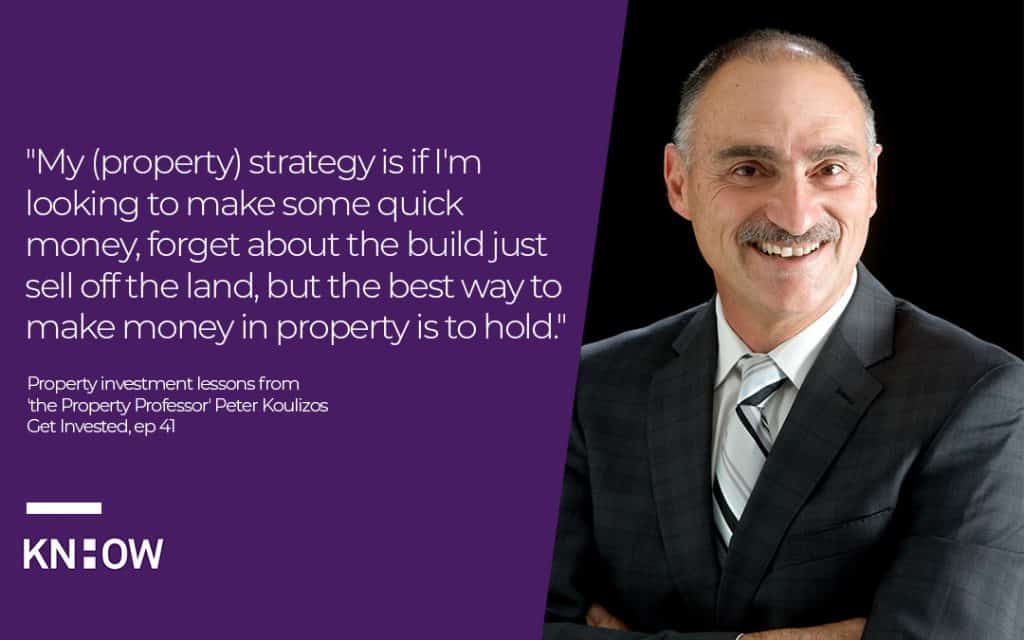Raised by a real estate agent and born with a passion for teaching, it seems Peter Koulizos was always destined to become ‘the Property Professor’.
Peter has written books and teaches property investment across TAFE, University of SA and University of Adelaide, taking his own real-world property investment experience into the class room.
For Peter, it has always been about living the lessons.
In his early years as a primary school teacher, Peter taught his students about investment by taking on an ambitious class renovation project.
“I probably wouldn’t try it these days, because the bloody paperwork involved would be horrendous, but one of the students in the class, her grandma was selling a unit, and we arranged so that we (me, the kids and their parents) would go and fix up the unit, and whatever it sold for above and beyond what we thought it was worth unrenovated, then we would take that cut,” Peter told Bushy Martin on the Get Invested podcast.
“We actually painted. We did up the garden. It was only a unit, so there wasn’t that much to do. It all sounds wonderful, but unfortunately, this was done around the time the GST was introduced, and the market was very soft.
“We didn’t make any profit, but there was a lot of learning, great learning that happened. Even to this day when I bump into some of those kids that I used to teach, they still remember that as a highlight of their school career, because it was real-life learning. It wasn’t just talking the talk, it was walking the walk.”
Peter was teaching in Ardrossan, a town in South Australia, and bought a home in the region simply because he couldn’t find a place to rent.
It would be the accidental beginning of his property portfolio.
Peter then went on to buy units in the town, picking up key insights that would influence his broader property investment strategy.
“What was really important about that was we had very good local knowledge, because we’ve heard of the term, ‘Location, location, location,’ and that is very important in property, and local information, in particular, information about the micro and the macro location, are so important when buying property, because the one thing you can’t change about a property is its location,” he said.
Peter then continued to build out his portfolio through multiple sub-division projects in the southern suburbs of Adelaide.
And, contrary to the views of some, Peter sees massive upside in building.
“One of the great things I like about building and holding is my costs are at a wholesale level,” he said.
“In class, I teach my students to work on a 20% gross profit, so the building … the whole thing is worth $600,000, so from day one, you’ve already got $100,000 worth of equity. Your mortgage is based on a $500,000 cost, but the tenant’s paying you based on the thing being worth $600,000. It’s not uncommon from day one to be neutrally or positively geared in a new property.
“Now, the downside is because it is new, and probably doesn’t have a lot of land, then there may not be as much capital growth, but that’s why location is so important, because in my opinion, location is the biggest driver of capital growth.
“Next comes land. Providing you’re holding those new properties in very good locations, then not only will your cashflow be good, you’ll also minimise your tax, because there’s great depreciation benefits, and one of the reasons your cashflow will be good is because you don’t have a huge amount of repairs and maintenance to do because it’s brand new.”
Peter has refined his strategy to give him options, depending on his circumstances and goals.
“My strategy is if I’m looking to make some quick money, forget about the build, just sell off the land, but the best way to make money in property is to hold,” he said.
“It’s not the only way to make money, but it is the best way to make money.”
Sometimes, the best way to learn about property investment is from mistakes.
“Some of the more severe mistakes I’ve seen people make is getting into property development before they’re ready, so some people want to go from zero to property developer, whereas they should go from nothing to buying one or more investment properties, and then when they are familiar with property, then by all means take the next step, because property development is riskier,” he said.
“Yes, you can aim for a 20% gross profit, which is great, but an increase in return also comes with an increase risk, so you need to be careful there.
“The other one is people that have bought apartments, and this is before they come into my class, because one of the first things I say in my very first lesson is, “If you don’t remember anything else from this course, please remember this. You are never, ever going to buy a brand new apartment or an off-the-plan apartment!”
Listen to the full interview here.
Want to Know How you can build wealth with property with the help of leading, qualified experts? Talk to the team at KnowHow, now.




